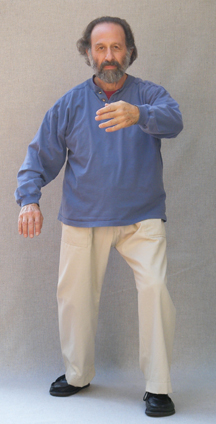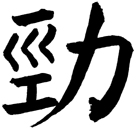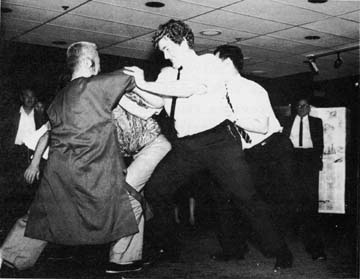
Peng, Jin, and Li*
Peng
Peng is upward, outward, sweeping movement, as exemplifed by movements such as “Ward Off Left” or “Diagonal Flying.”

The character for peng.1
In fact, the Chinese name for the movement usually referred to as “Ward off Left” has the character for peng at the end and is usually translated as “Grasp Sparrow’s Tail Left.”

Chinese characters for “Ward Off Left” (Lan Que Wei Zuo Peng)

Robert Chuckrow in “Ward off Left.”2
If you show several Chinese people the characters for something in T’ai Chi (these are usually old characters), often each person will have a different interpretation. One such interpretation here is “The Sweep of the Peacock’s Tail Left Peng.”
Li and Jin
 |
 |
|
Li
|
Jin
|
The characters for li and jin, respectively. The character for li represents ordinary strength. On the other hand the character for jin, which contains li, has an extra element, making jin mean “educated strength.”
Peng is simply upward, outward movement. However, in T’ai Chi, all movement should be initiated by jin rather than li. This distinction is something that T’ai-Chi practitioners often have a hard time understanding, and those who can manifest jin often have a hard time explaining it. Li is the strength that most people are accustomed to using. In my interpretation, li arises from contractive muscular action (muscles contracting, causing bones to move). Jin, on the other hand, is strength that is cultivated from practice—usually of T’ai-Chi movement. In my interpretation, jin arises from active muscular extension (muscles extending, causing bones to move). Jin can be maintained for much longer periods of time than li and is much more beneficial to the body (more conducive to the flow of Read a biological interpretation of ch’i).
When doing the movements of the T’ai-Chi form, a small amount of jin is required for raising arms against gravity, lowering them more slowly than they would fall, rotating wrists, and changing the speed or direction of motion of the body. Moreover, in push-hands practice, the neutralizing and pushing forces must be initiated by jin, not li.
When it comes to using strength against another person, li is brittle and awkward, but jin is unified and enables the one who uses it to be “rooted.” Read how to recognize the difference between li and jin.
The following two quotes, which may shed some light, are (1) from my first teacher, Cheng Man-ch’ing, who studied with Yang Cheng-fu, and (2) from Chen Wei-Ming, an “older brother” of Cheng under Yang:
In his book, T’ai Chi Ch’uan: A Simplified Method of Calisthenics for Health & Self Defense, North Atlantic Books, Berkeley, CA, 1981, pp. 16–17, Cheng Man-ch’ing talked about developing “tenacious strength,” or “tenacity.” According to Cheng, “Tenacity is the resistance or tonicity of living muscles. The muscles being relaxed, tenacity cannot involve the bones. Force, on the other hand, is derived from muscles, binding the bones together into a wooden (rigid) system.”
The following quote is from Chen Wei-Ming, T’ai Chi Ch’uan Ta Wen Questions and Answers on T’ai Chi Ch’uan, Translated by Benjamin Pang Jeng Lo and Robert W. Smith, North Atlantic Books, Berkeley, CA, 1985, pp. 57–58:
“Chin [Jin]: One of the main objectives of T’ai Chi Ch’uan is the development of Chin or internal force. Chin is contrasted with li, which refers to muscular contraction and release. Chin is said to generate power from the sinews [tendons] rather from the muscles binding together and striking with the bones. Chin is developed through circular changes while the flexations of li follow straight lines.”

In the above photograph, four people are pushing Cheng Man-ch’ing’s extended arm. Cheng was renowned for not collapsing his arm and not moving during such demonstrations. (From T’ai-Chi Ch’uan, Body and Mind, published by Tai Chi Chuan Association, 211 Canal Street, New York, NY, 1968.)
1All of the above characters were drawn by Jizhen Sun Bredeche.
2From Robert Chuckrow, Tai Chi Dynamics, YMAA Publication Center, Inc., PO Box 480, Wolfeboro NH 03894, 2008, cover.
©Copyright 2010 by Robert Chuckrow. Revised 5/16/11.
Related Article: Cultivating the Correct Internal State in T’ai-Chi Movement